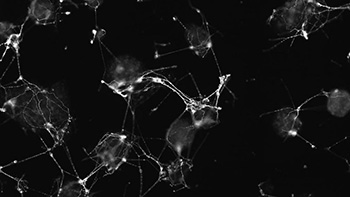
A brain-like network of neural progenitors 96 hours after being stimulated to turn into neurons. Credit: Image courtesy of Thomson lab/UCSF
In a series of in vitro studies, researchers from the University of California, San Francisco (USCF, USA) optically induced sustained expression of the Brain2 (Brn2) gene to initiate engineered embryonic stem cells (ESCs) to turn into nerve cells (Cell Systems, doi: 10.1016/j.cels.2015.08.001). Past studies have failed to identify how ESCs distinguish authentic cues to differentiate from background gene expression noise. The USCF findings could advance scientists’ understanding of stem cell fate, which may one day lead to a wide variety of therapeutics—from more effective cancer drugs to tissue and organ regeneration.
In previous ESC studies, scientists observed fluctuating expression levels of the genes that control cell fate. But it’s been unclear how the ESC “decides” which differentiation cues to obey. To determine how ESCs filter out the real cues from all that noise, the UCSF researchers engineered mouse ESCs to turn on the Brn2 gene—a cue for neuronal differentiation—when exposed to blue light. They then exposed the mouse ESCs to pulses of blue light from an LED matrix.
By varying the duration and strength of the light, they found that they could control the amount of Brn2 expression; and with the right level of expression, the ESC would differentiate into a nerve cell. Short 300 µW light pulses over the course of one hour were ignored, while constant 24-hour light exposure at 300 µW drove rapid neural differentiation.
The team also wanted to know how and why the engineered ESCs only paid attention to the long light pulses and not the short ones. To do this, they added a fluorescent tag to Nanog, a transcription factor that typically blocks stem cell differentiation. So when they detected the presence of Nanog from its fluorescence, they could record the observation as the ESC’s decision to ignore Brn2 expression and remain pluripotent—that is, capable of giving rise to multiple different cell types.
When Brn2 is turned on for an extended period, the researchers say it disrupts the positive feedback loop that maintains the ESC’s undifferentiated, pluripotent state. In response to this disruption, Nanog levels are downregulated—taking about four hours to completely disperse. Matthew Thompson, one of the paper authors, describes Nanog degradation as a buzzer going off. “And once it goes,” says Thompson, “it really goes—the cells rapidly start converting into neurons.”
The researchers believe that mechanisms similar to the Brn2/Nanog mechanism may control other forms of stem cell differentiation. The UCSF team has provided a video of ESCs differentiating into neurons under optical control.
